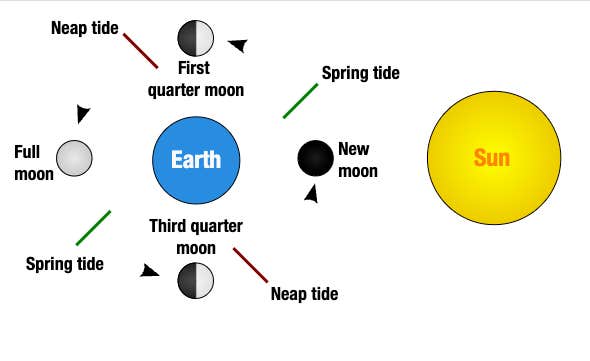What Is A Spring Tide?
Never look at the beach in the same way again.
 Davide Angelini / shutterstock
Davide Angelini / shutterstock What causes the ocean to swell? It's not just the Moon that has a gravitational pull on spring tides.
The Earth’s gravitational force pulls the waves down, thus resulting in high and low tides.
What is a spring tide?
A spring tide, also known as a King Tide, is a concept that tides "spring forth" twice each lunar month.
The waters are essentially being tugged at by the gravitational pulls of the Moon and the Sun as they are interacting with the position of the Earth.
Spring tides occur when the Sun is aligned with either a Full or New Moon.
This happens twice a month and causes a much more exaggerated high and low tide.
Spring tides are one of the most fascinating natural occurrences you'll ever see.
What happens at a spring tide?
Most people understand that any ocean waves are controlled by the gravitational force of the Moon.
Gravity is when all matter attracts itself to other matters. As a result, we all live on this round planet called the globe.
Imagine this, if there wasn’t a Moon, there wouldn’t be rigid land, every ocean would be the same surface-level depth, and Earth would be a smooth round ball!
The Earth’s dynamic physical features are due to the forces of the Moon.
Of note, the tides are higher the closer the Moon is or when it’s on the opposite side of the Earth.
Since the Earth rotates constantly over 24 hours, there are always two high tides and two low tides.
Every six-hours, you can expect either a high or low tide to occur.
Both the Earth and the Moon follow an ‘elliptical path,’ which measures the distances between them and the Sun.
The alignment of the Sun with the Moon greatly affects the tides as well.
If the Sun is directly aligned to the Moon, then the tides become greater. If the Sun is further, then its gravitational force fights against the Moon.
Alternatively, when there’s very little change in sea level at low and high tide, then that’s due to ‘neap tides.’ Neap Tides occur only during a quarter Moon, and when the Sun and Moon are working against each other.
This also leads to tidal bulges, which causes the tides to become weaker during this Moon cycle.
Spring and neap tides usually have a twenty percent high and low range in comparison.
 Photo: Wikipedia
Photo: Wikipedia
The term neaps come from Anglo-Saxon, meaning without power.
If you’re a fan of watching massive waves, then you should probably take a trip to Nova Scotia, Canada.
There they have a beach called the Bay of Fundy, which produces the highest tides in the world.
When is the next spring tide?
It's commonly thought that spring tides occur in the Spring, but actually they happen multiple times a month.
You can check when the next one happens by looking at a spring and neap tide planner.
What is the difference between high tide and spring tide?
There is a high tide twice a day every day, these are normal.
Tides called Spring tides, however, only happened when there is a New or Full Moon.
Spring tides are different in this way because during those two moon phases the gravitational pull of the sun is stronger, causing the oceans to bulge a bit more than usual.
This means that high tides are a little higher and low tides are a little lower than average.
There’s also a tide called the perigean spring tide.
This occurs when the Moon is full and it’s closest to the Earth.
The difference between these tides and spring tides is typically between five centimeters two inches.
If you ever notice the Moon extremely close to the Earth, then it’s probably in the ‘perigee’ cycle.
Once a month the ‘perigee’ creates the strongest tides, because of the short distance between the Moon and the Earth.
Interestingly enough, two weeks after the Moon is experiencing its weakest cycle called, ‘apogee.’
This means the Moon is furthest away from Earth, resulting in the weakest gravitational pull.
During the seasons, perigean spring tides can cause minor coastal damage as well as nuisance flooding.
Although, if a storm occurs during the perigean spring tide, then you can be sure the flooding will be exponentially great.
An ‘equinoctial spring tide is when spring tides align with either the March equinox or the September equinox.
When the Sun and Moon are aligned with the equator, then expect large tidal ranges of the year.
Why spring tides are important:
When we learn the highs and lows of certain tides, we can prepare for the best outcome.
For example, a surfer or swimmer can better decide when it’s safer to go hit the waters.
Spring tides are a beautiful reminder that we’re all being pulled together by gravity.
When we learn when spring tides are high or low, we're better prepared when to ride the waves and have fun while enjoying the beach.
Are spring tides dangerous?
If someone is in an area that’s close to the bay, then it would behoove them to better prepare for any safety measures.
A ‘conjunction’ is when both the Moon and the Sun use their gravitational forces to raise the tides.
This creates higher chances of coastal storms.
The more whole the Moon is, then the greater the tides will be.
The gravitational energy will be extraordinary to experience with family and friends.
Listening to the waves gently crashing against each other, helps anyone to have a relaxing beach vacation.
What time of year are tides the highest?
The highest tides happen when the moon is either New or Full.
That is, spring tides are the highest tides and they happen every month no matter the season.
However, they can become exceptionally high during the winter and summer solstices.
Sofia Stewart is a writer who covers astrology, spirituality, love, and relationship topics.

